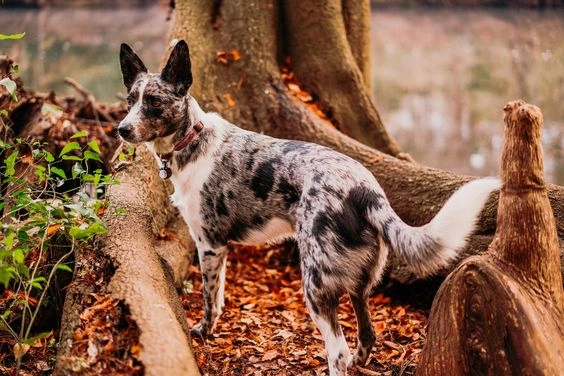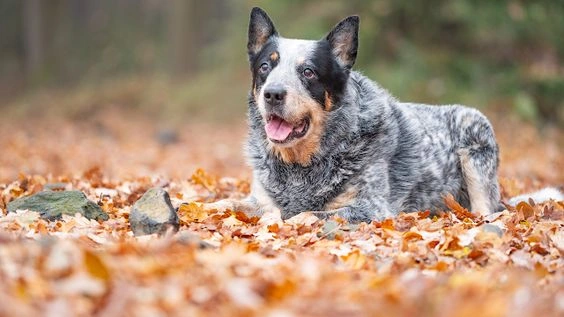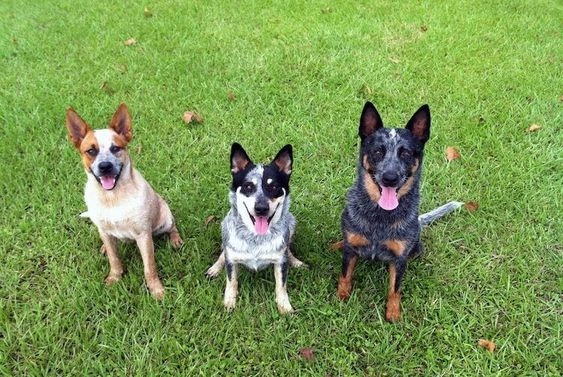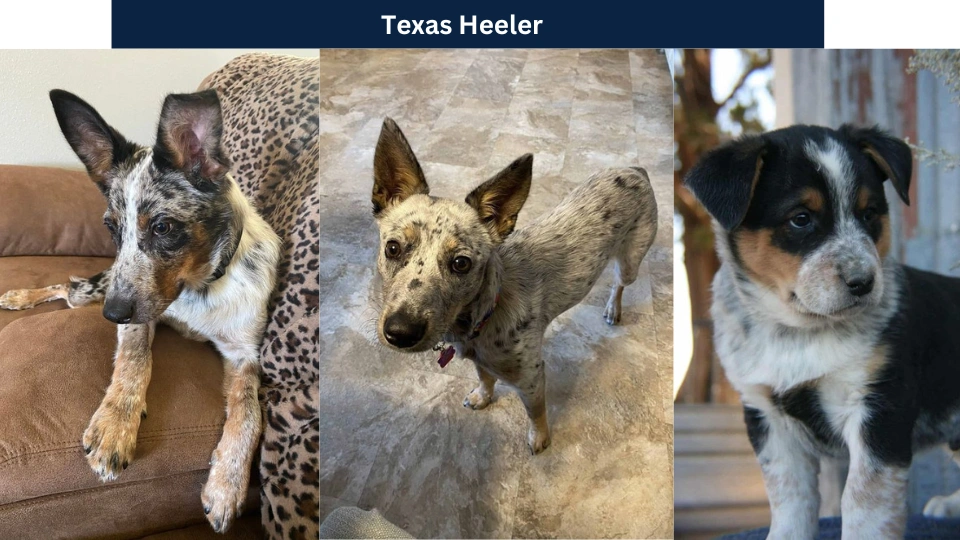Last Updated on March 12, 2024 by Aftab Tariq
Texas heelers are a type of dog with special blue-coloured fur. They are really smart and full of energy. They resemble a cross between an Australian shepherd and a cattle dog native to that country. They got their name from Texas, where they’re often seen.

People also call them “heelers” because they’re good at helping with cattle, just like the Australian cattle dog. A Texas heeler might be a great choice if you like staying active.
They’re super clever and love having tasks to do, especially playing games or doing sports. These dogs are also very loyal and love being part of a family, especially if they’ve been around kids and other pets since they were young. In this article we will discuss about Texas Heeler.
History Of The Texas Heeler

The Texas Heeler is a mix of two purebred dogs, becoming popular in the 1970s as a working dog on farms and ranches in Texas. Lucy Guynes registered the breed with the Animal Research Foundation in May 1970.
The breed’s story is interesting because it combines traits from the Australian cattle and shepherd dogs. These parent breeds were originally developed in the 1800s by Australian settlers for herding cattle and adapting to the tough Australian climate.
The Australian cattle dog, the blue heeler, was bred by mixing English dogs with native Australian dingoes. This created a hardy dog that could withstand the challenges of ranch life. In 1893, Robert Kaleski began breeding blue heelers, recognized by the American Kennel Club in 1980.
Characteristics Of The Texas Heeler

Texas heeler, a mix of two smart and active breeds, could be the perfect companion if you enjoy staying busy. They thrive on outdoor adventures and are great at keeping up with your active lifestyle. However, they can be stubborn if they are not trained well.
So, it’s important to start teaching them commands early and establish who’s in charge. Keeping them mentally and physically engaged will help them stay well-behaved.
Why Are They Called Texas Heelers?
The Texas Heeler gets its name from its place of origin, Texas. It’s a mix of the Australian cattle dog and the Australian shepherd. This medium-sized breed was specifically bred for herding cattle. Known for being energetic and intelligent, they are excellent for training as long as you can match their energy level.
Texas Heeler Puppies

Texas Heeler puppies benefit greatly from early training and socialization to prevent aloofness or nervousness around strangers and manage their energy levels. Their quick learning and adaptability in youth make establishing routines easier.
Neglecting this early training can pose challenges, but adult Texas Heelers can still be effectively trained with their intelligence and responsiveness. Patience, treats, and positive reinforcement are essential to compensate for lost time during puppyhood.
Texas Heeler Care
Texas Heelers have the potential to be wonderful family pets; nevertheless, it is essential to begin training them at an early age and to do so frequently to harness their intellect and energy
efficiently.
Because they are an active breed, they thrive in a house that provides plenty of space for them to run around and provides access to activities such as dog parks and hiking trails. They have the potential to be a devoted companion for many years to come if they are given the due care and attention.
Exercise For Texas Heeler

Texas Heelers need lots of daily exercise because they come from two active herding breeds. Texas heelers come from two energetic herding breeds, so they need to move around a lot. They love having something to do and are good at tasks.
They enjoy running and cycling with you but also like playing games and doing activities that make them think. Because they have an instinct to herd, walking them on a leash and keeping them near you when you’re outside is important.
Grooming For Texas Heeler

For a Texas Heeler‘s grooming needs, even though their coats are short to medium in length, they’re dense and have two layers, so they usually shed quite a bit. Especially during spring, their undercoat might shed heavily.
Brushing them at least once or twice a week using a bristle or pin brush is a good idea to keep their coat healthy and minimize shedding. Aside from brushing, remember to regularly brush their teeth, clean their ears, and trim their nails. If you find these tasks challenging, consider finding a professional groomer nearby who can help you out every few weeks.
Texas Heeler’s Fur
The parents of a Texas Heeler affect its fur. Smooth, 1–3-inch coatings are usual. The Texas Heeler comes in black, blue merle, or blue with white or tan markings. Their ears normally stand up but may flop. Many Texas Heelers are born with short, bobbed tails.
Training For Texas Heeler

Training a Texas Heeler is relatively easy because they’re super smart. They live with their families but can be wary of strangers, which makes them good watchdogs (even if they don’t bark unless they see something unusual).
They’re usually good with kids but might need to learn not to nip or herd them occasionally. If you have other pets, it’s best to introduce your Texas Heeler to them when they’re young so they don’t try herding them, especially if the other pets are smaller.
Texas Heeler Lifespan
The Texas Heeler breed usually lives around 12 to 15 years, which is quite a good lifespan for dogs. However, they can face health issues if not looked after well. But with proper care and attention, they can live even longer, maybe surpassing 15 years. That’s a lot of time to spend with your furry friends, whether they’re a mix of breeds or not. Take good care of them, and you’ll make many happy memories together.
Texas Heeler Size
The Texas Heeler is a medium-sized dog, usually reaching a height of 17 to 22 inches when fully grown. Texas heeler weight is between 25 and 50 pounds. They’re usually strong, tall, and lean because they inherit good traits from both parent breeds.
Despite reaching 50 pounds, they don’t tend to become overweight easily. They’re naturally athletic, energetic, and muscular. But they need lots of exercise and a balanced diet to keep them healthy.
Diet And Nutrition For Texas Heeler
Every dog, including the energetic Texas Heeler, needs good food to stay healthy. They require meals packed with nutrients to keep up with their lively nature. Dry dog food designed for active breeds is usually the best choice for Texas Heelers. This food provides the energy they need to stay active all day. Ensure the food matches their size (medium) and age (puppy, adult, or senior).
It’s essential to feed your Texas Heeler appropriately. Following the recommended serving sizes on the food packaging can help prevent them from becoming overweight. Texas Heelers should eat at most 3 cups of kibble daily.
Feel free to talk to your vet if you need more clarification about your dog’s diet. They can offer personalized advice based on your Texas Heeler‘s specific needs. Every dog is different, so consulting with a vet ensures your furry friend gets the right nutrition.
Common Health Problems
Texas heelers are usually in good health but might face health problems. If you see signs of the following issues or health concerns, reach your vet immediately. Some common health problems in Texas heelers are:
1: Hip and elbow dysplasia: Their hip or elbow joints might not develop correctly, causing discomfort or difficulty in movement.
2: Distichiasis: This is when extra eyelashes grow on the inside of the eyelid, which can irritate the eye.
3: Progressive retinal atrophy: This is a serious condition where the eyesight worsens over time and can lead to blindness.
Texas Heeler Rescue Groups
Because Texas Heelers are a mixed breed, locating a rescue organization dedicated to one particular breed may be challenging.
However, consider adopting a rescue dog that is particular to the breed of Australian Shepherd or Australian Cattle Dog, as these sanctuaries frequently take care of mixed breeds. Here are some rescues that you might want to try:
The Australian Cattle Dog Rescue Association
Texas Heeler Vs Blue Heeler
One of the most significant distinctions between the Blue Heeler and the Texas Heeler is that the Blue Heeler is a purebred. In contrast, the Texas Heeler is a hybrid of the Australian Cattle Dog and the Australian Shepherd. As well as their size, look, temperament, trainability, barking volume, and grooming frequency, other distinguishing characteristics include their personality.
Are Texas Heelers Aggressive?
Texas heelers are usually not known to be aggressive dogs. But they might be cautious around new people and bark or stay away until they feel at ease. Because they have a herding instinct, they might try to gather up small children or pets, sometimes gently nipping at them to guide them.
Where To Adopt Or Buy A Texas Heeler?
Texas heelers, technically classified as a “designer breed,” often require finding a breeder if you want to adopt one. Sometimes, you might find them in shelters or specific rescues like the Texas Cattle Dog Rescue. When choosing a breeder, ensure they’re reputable. Both parents’ health and immunization records and healthy litters are required. Breeders usually charge $500–$1000 for Texas heeler puppy.
Frequently Asked Questions
Are Texas Heelers Loyal?
Texas Heelers are loyal buddies who travel wherever you go. They love their family but are suspicious of outsiders. Grooming Texas Heelers is easy, as expected for an outdoor dog.
What Are Texas Heeler Colors?
The following colours are used for Texas heelers: black, blue, brown, chocolate, liver, fawn, and grey.
Source
I am a dedicated content writer with more than five years of experience, particularly skilled in the art of storytelling. My writing journey commenced during my college years, where I pursued journalism and unearthed my talent for creating captivating narratives.


